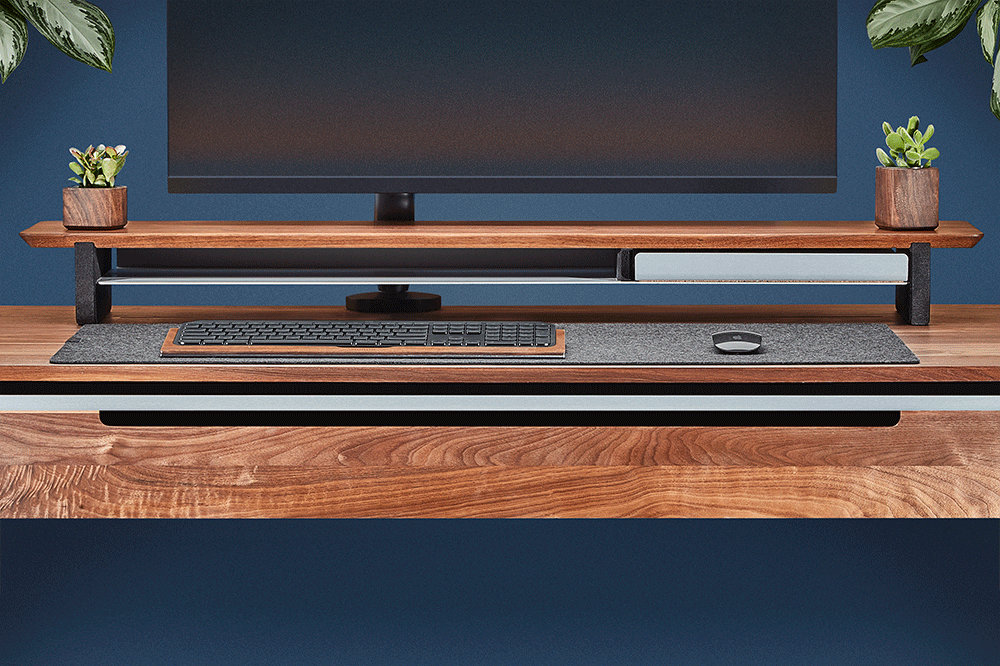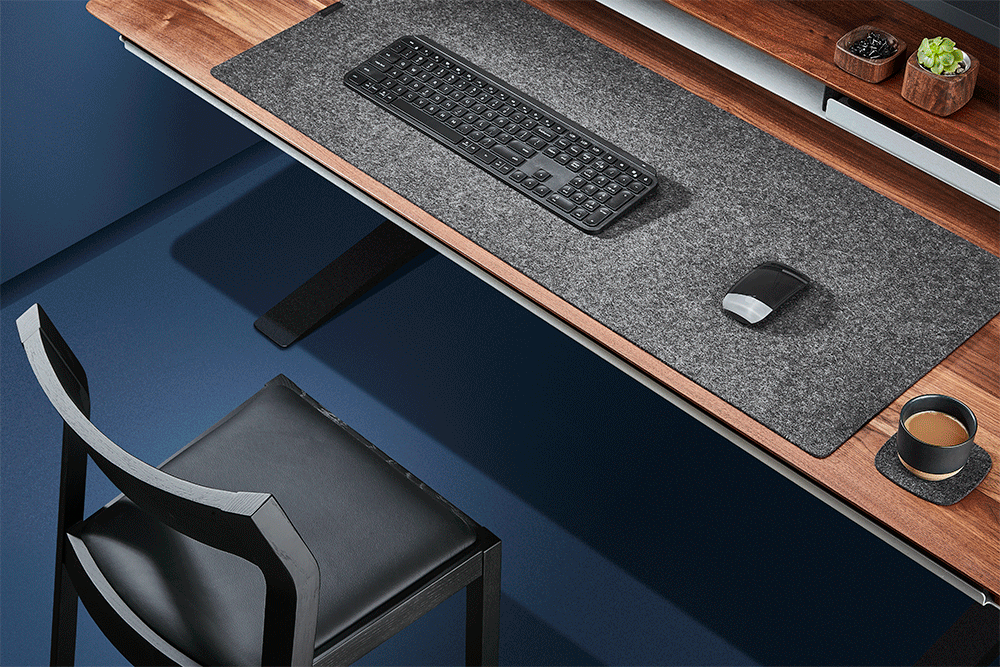Designing the Desk
It took a coordinated effort that spanned years—come behind the scenes with our design team and read the story of how we designed our desk.
Just What Your Home Office Needs
In the end, the first Grovemade Desk is designed to be the perfect solution for a single user: someone who works at their desk day in, day out. It's designed to have basically no compromises between form and function.

This design is next level—every element and function is aligned and has to be totally coordinated.
KEN TOMITA
Co-Founder
The History
Let's go back in time for a moment. The desk in its final iteration actually built on at least six years of iterative design work—the first desk designs were started in 2018, while our headquarters were still in the central eastside industrial district in Portland.

KEN TOMITA (Grovemade Co-Founder): At the time, we knew we wanted to design a desk—it was a natural extension from our desk collection and desk shelf system product lines. We started with a very sculptural vision of a sitting desk.

SEAN KELLY (Lead Designer): While Ken and Ben Wood (our engineer) were occupied with moving our headquarters, I spent the year working on a desk design. We wanted something that was visually sleek, architectural, and also functional.
The early explorations laid some of the conceptual framework that we carried forward—focus on marrying form and function, solve the storage solution in an elegant way, and coordinate with the whole Grovemade lineup of products.
Pivot to Standing
Sean: We immediately started thinking about all the challenges of standing desks: the top moves, the cords move. You have five to ten cords per desk. All of them move up and down and it's this constantly changing cord spaghetti.
Ken: And sometimes standing desk legs can feel too mechanical. A little orthopedic.
Sean: They look like a device, not a piece of furniture.
Ken: And sometimes standing desk legs can feel too mechanical. A little orthopedic.
Sean: They look like a device, not a piece of furniture.

Everyone needs to store a lot of things—we've been saying this since 2017 when we designed the original desk shelf system— and it's been true for a long time. In the growth of the standing desk phenomenon, however, the focus on storage was lost.
Ken: If you think of home office desks from previous eras, from classic and iconic to run of the mill, they all had ample storage because one of their basic functions was to hold things. The standing desk as a simple ergonomic commodity eliminated storage. It's complex to deal with storage on a desk that moves. But we knew we had to solve the storage issue.
We realized our first desk would be a sit-stand adjustable, and we'd make sure it solved the problems in a meaningful way while being something that would inspire your best work.
Ken: If you think of home office desks from previous eras, from classic and iconic to run of the mill, they all had ample storage because one of their basic functions was to hold things. The standing desk as a simple ergonomic commodity eliminated storage. It's complex to deal with storage on a desk that moves. But we knew we had to solve the storage issue.
We realized our first desk would be a sit-stand adjustable, and we'd make sure it solved the problems in a meaningful way while being something that would inspire your best work.

The Two Pillars
Cord management and storage. Standing desks were in need of both, and we were going to try to design one that lived up to our standards. The first challenge was selecting the frame we would build around.
Ken: I think what really helped early in the process was when we committed to using the two legged “C-style” sit-stand base. It meant we could focus our design work to make a desk that looked like a coordinated whole, rather than a bunch of different pieces tacked together.
Ken: I think what really helped early in the process was when we committed to using the two legged “C-style” sit-stand base. It meant we could focus our design work to make a desk that looked like a coordinated whole, rather than a bunch of different pieces tacked together.

Sean: It gives a different feeling to a furniture piece when all the components are designed specifically for that one piece, rather than off the shelf and compatible with a bunch of different desks.
For over a year, Ken and Sean worked to refine and experiment. We got to a point where Ken thought the desk was good enough to launch, but Sean disagreed—a natural part of the design process! The project stalled. Sometimes getting another voice involved can help break up an impasse. In this case, Jim, our CEO, was that voice.


JIM HASSERT (Grovemade CEO): Basically, I told Sean and Ken that I supported them going all the way, to keep pushing the innovation and differentiation as far as they could.
After breaking through the impasse, the years of work on the desk started to really consolidate and our efforts felt fast and effective. Once we had clarity on what the Grovemade desk needed to be, many of the elements just started to click into place.
Sean: It happened really quickly.
Ken: We had already done some of the work. So even if you have to pivot at the last minute and kind of reset, you're not really starting from scratch. You compress the timelines.
With our energy renewed, we started to work on the two integrated components: the power panel and the ultrawide drawer.
Sean: It happened really quickly.
Ken: We had already done some of the work. So even if you have to pivot at the last minute and kind of reset, you're not really starting from scratch. You compress the timelines.
With our energy renewed, we started to work on the two integrated components: the power panel and the ultrawide drawer.
The Power Panel
The funny thing about cord management is that everyone wants it, there are tons of solutions out there—but when you talk to people, very few are satisfied with it.


NICK LAPLANTE (Director of E-Commerce): Even if cord management products are cheap and accessible, people don't like them. It's like they don't work. They don't solve everything.
Ken: I think it's also because people have to do the work to figure it out. You have to go to Amazon, cobble together all these cheap things and design it yourself.

So we needed something simple yet effective. We landed on a design that included a wide, accessible trough, so you could throw your cords in without too much effort, but which would also allow for detailed cord routing work.
Another important element of the power panel was designing for access from the front.
Ken: A giant inflection point was noticing that a lot of cord management requires you to get to the back of the desk, which you usually don't have access to. Desks are really heavy, you have to move it out, you have to move your furniture, you might damage your floor. It's just a pain to go back and fuss with stuff. But one day, Sean raised his desk and just slid under there. He didn't even get out of his chair. It was so easy.
Ken: A giant inflection point was noticing that a lot of cord management requires you to get to the back of the desk, which you usually don't have access to. Desks are really heavy, you have to move it out, you have to move your furniture, you might damage your floor. It's just a pain to go back and fuss with stuff. But one day, Sean raised his desk and just slid under there. He didn't even get out of his chair. It was so easy.

Because we were designing a single desk for a single user, we could design the power panel to fit perfectly tight against the frame. Wrapping it in wood panels helps balance the overall visual, and gives an easy way to hide and access cords. The early versions of the power panel had a hinge-type opening—the front would tip open toward you. However, as we designed the initial drawer concepts, we needed to switch to a vertical latch system.

Ken: Everyone needs power—but we wanted to make sure it was minimal. The integrated surge protector in the power panel means you don't have to think about it—it's just there. We added a 12-foot long custom braided cord to get that single cord bliss.
The power panel coordinates with the other elements of the desk to really shine, which brings us to the drawer.
The power panel coordinates with the other elements of the desk to really shine, which brings us to the drawer.

Making Magic Work


It's super thin in the front, so it doesn't scream "storage." But then when you reach underneath and pull the hidden handle, it reveals everything you need for your work, from small tools to laptops and iPads.
SEAN KELLY
Lead Product Designer
Each element of the drawer was designed for a specific purpose. The materiality drew heavily on our classic palette: merino wool indicates a space that's soft and can accept your tech; cork is defined three dimensionally, making for beautiful compartments; and the wood provides structure and warmth.

Designing the interior zones was based on how we use storage: there are things you need to access frequently, and others that are less frequent. The wedge shape coordinates with the front row of cork pockets, giving you quick access to small things when the drawer is pulled out slightly. Pull it out further to reach the larger compartments where you can store your laptop (with vents to keep it cool, plus channels to route your cords to the power panel).

Our drawer design called for a fully cantilevered open position, to help you access your stuff without digging around in the dark. This, however, presented a huge engineering challenge. In almost all cases, drawer slides are mounted to the side. However, we couldn't use a side mounting system—the sides extend fully past the edge of the frame and are always visible. We spent countless hours trying to solve this puzzle.

Ken: We explored a lot of different ways to make it work, integrating different types of hardware into these designs. And the final hardware that we needed to make it work is pretty cool—we're using these linear guides from CNC machines. They're super specialized and technical and hard to find.
The linear guides attach to the bottom of the desktop—totally invisible—and rails on the drawer allow it to effortlessly glide in and out.
The linear guides attach to the bottom of the desktop—totally invisible—and rails on the drawer allow it to effortlessly glide in and out.

Sean: It's just so cool. It's got a huge cantilever. It doesn't feel like a regular drawer at all. The angle makes it feel hidden, but it also provides space for your legs. A lot of drawers have to be on the sides so that your legs have an opening in the middle. This one maximizes storage without making it too tall or thick.
Ken: And there's something really satisfying about the full width.
Ken: And there's something really satisfying about the full width.

Essentially Custom

We're maximizing the entire space between the legs because we designed a single desk for a single user.
SEAN KELLY
Lead Product Designer
Starting with a clear objective helped us navigate the labyrinth to make a desk that we really love.
All in all, the desk was our biggest, most challenging, and ultimately most satisfying product design in our 15 year history. There are more stories to tell—how we designed the pocket sizes in the drawer, the challenges of assembly instructions, or figuring out how to build and ship something so big—but for now, we'll call it a wrap.
All in all, the desk was our biggest, most challenging, and ultimately most satisfying product design in our 15 year history. There are more stories to tell—how we designed the pocket sizes in the drawer, the challenges of assembly instructions, or figuring out how to build and ship something so big—but for now, we'll call it a wrap.
Shop the Desk System
Our standing desk is available in three wood finishes—walnut, oak and maple. It was designed to coordinate with our entire desk collection to build the ultimate home office.




























































